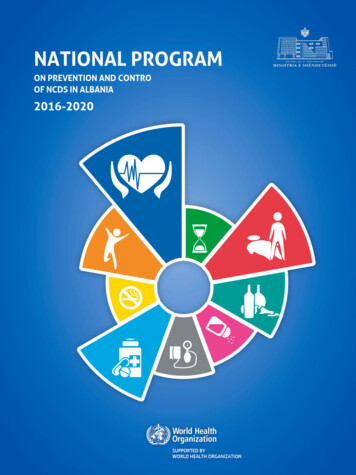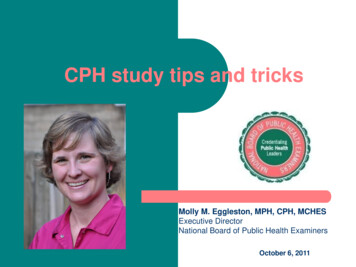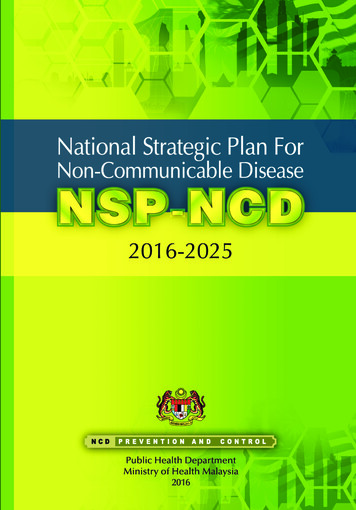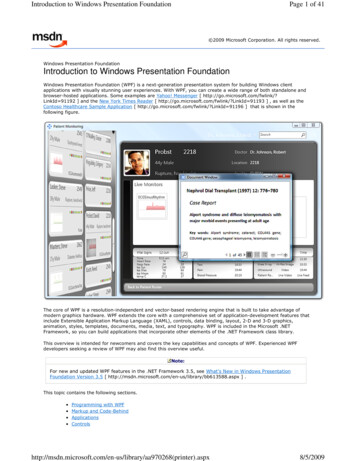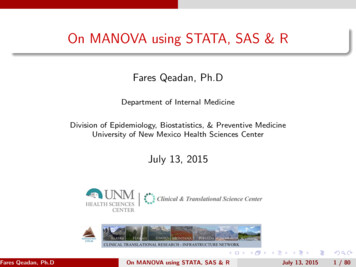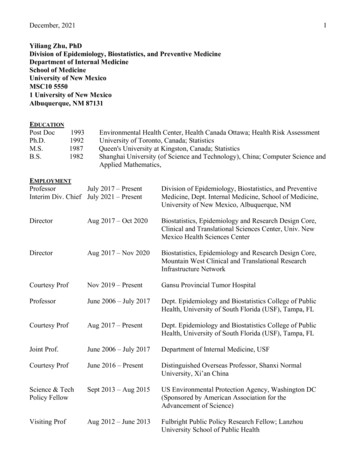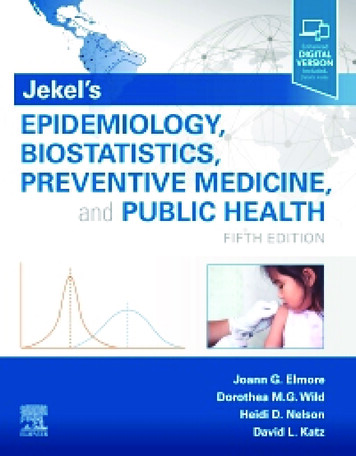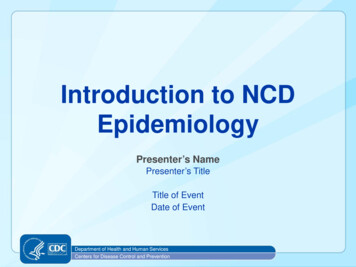
Transcription
Introduction to NCDEpidemiologyPresenter’s NamePresenter’s TitleTitle of EventDate of EventDepartment of Health and Human ServicesCenters for Disease Control and Prevention
Learning ObjectiveAt the end of the training, participants will be ableto describe how to use epidemiology to address apublic health problem.Introduction to NCD Epidemiology2
Lesson Overview Basic terminology Comparison of non-communicable diseases andcommunicable diseases Definition and approaches of epidemiology Public health management cycle Core functions of epidemiologyIntroduction to NCD Epidemiology3
Non-Communicable Disease(NCD): DefinitionNoncommunicable diseases (NCDs), also knownas chronic diseases, are not passed from personto person. They are of long duration and generallyslow progression.(WHO, 2011)Introduction to NCD Epidemiology4
Non-Communicable Disease(NCD): Definition (cont.) Chronic conditions are characterized by thefollowing:– Do not result from an (acute) infectious process– Are “not communicable”– Cause premature morbidity, dysfunction, andreduced quality of life– Usually develop and progress over long periods– Often initially insidious– Once manifested there is usually a protracted periodof impaired healthIntroduction to NCD Epidemiology5
Non-Communicable Disease(NCD): Extended DefinitionIn some definitions, NCDs also include: Chronic mental illness Injuries, which have an acute onset, but may befollowed by prolonged convalescence andimpaired functionIntroduction to NCD Epidemiology6
Types of NCDs Cardiovascular disease (Coronary heartdisease, Stroke) Cancer Chronic lung disease Diabetes Chronic neurologic disorders (Alzheimer’s,dementias) Arthritis/Musculoskeletal diseaseshttp://www.who.int/gho/ncd/mortality morbidity/en/index.htmlIntroduction to NCD Epidemiology7
Leading Causes of Attributable GlobalMortality and Burden of Disease, 2004Attributable MortalityAttributable DALYshttp://who.int/healthinfo/global burden disease/GBD2004ReportFigures.pptIntroduction to NCD Epidemiology8
Characteristics of NCDs Complex etiology (causes)Multiple risk factorsLong latency periodNon-contagious origin (non-communicable)Prolonged course of illnessFunctional impairment or disabilityIncurabilityInsidious onsetIntroduction to NCD Epidemiology9
Risk Factor“An aspect of personal behavior or lifestyle, anenvironmental exposure, or a hereditarycharacteristic that is associated with an increase inthe occurrence of a particular disease, injury, orother health condition.”(Principles of Epidemiology, CDC, 2006)Introduction to NCD Epidemiology10
Modifiable Risk FactorA risk factor that can be reduced or controlled byintervention, thereby reducing the probability ofdisease.The WHO has prioritized the following four: Physical inactivity Tobacco use Alcohol use Unhealthy dietsIntroduction to NCD Epidemiology11
Non-Modifiable Risk FactorA risk factor that cannot be reduced or controlledby intervention, for example: Age Gender Race Family history (genetics)Introduction to NCD Epidemiology12
Common Risk FactorsIntroduction to Epidemiology13
COMPARISON OF NCDS ANDCOMMUNICABLE DISEASESIntroduction to NCD Epidemiology14
Communicable Disease:Definition An infectious disease transmissible (as fromperson to person) by direct contact with anaffected individual or the individual's dischargesor by indirect means (as by a vector) Examples:‒ Measles‒ Dengue‒ TyphoidMerriam-Webster Communicable Disease Definition WebsiteIntroductionto NCDEpidemiologyIntroductionto NCDEpidemiology15
Non-Communicable Diseasesvs. Communicable Diseases How do they differregarding:– Infectiousness?– Risk of Disease?Introductionto NCDEpidemiologyIntroductionto NCDEpidemiology16
DEFINITIONS ANDAPPROACHES OFEPIDEMIOLOGYIntroduction to NCD Epidemiology17
What is Epidemiology?Introduction to NCD Epidemiology18
Epidemiology: CDC Definition“The study of the distribution and determinants ofhealth-related states in specified populations, andthe application of this study to control elated Statesspecified PopulationApplication(Last, 2001)Introduction to NCD Epidemiology19
Epidemiology: CDC DefinitionDistributionDistribution: Occurrence of cases by time, place,and personExample: According to a study of deaths in Country X in2008, 1,034 cervical cancer deaths occurred amongwomen between the ages of 45-54.Introductionto NCDEpidemiologyIntroductionto NCDEpidemiology20
Epidemiology: CDC DefinitionDeterminantsDeterminants: All the causes and risk factors forthe occurrence of a disease, including physical,biological, social, cultural, and behavioral factorsExample: Smoking was a risk factor ordeterminant for the greater number of cancerdeaths among women ages 45-54 in Country X.Introductionto NCDEpidemiologyIntroductionto NCDEpidemiology21
Epidemiology: CDC DefinitionHealth-Related StatesHealth-related states Diagnosis of a specific disease or cause ofdeath Health-related behavior (e.g., smoking, takingprenatal vitamins) Example: According to the 2008 study inCountry X,1,034 cervical cancer deathsoccurred among women between the ages of45-54.Introductionto NCDEpidemiologyIntroductionto NCDEpidemiology22
Epidemiology: CDC DefinitionSpecified PopulationSpecified Population: A measurable group, definedby location, time, demographics, and othercharacteristicsExample: Women aged 45-54 living in a ruralvillage in Country X from 2001 through 2009.Introductionto NCDEpidemiologyIntroductionto NCDEpidemiology23
Epidemiology: CDC DefinitionApplicationApplication Analysis, conclusion, distribution, and timelyuse of epidemiologic information to protect thehealth of the population Example: As a result of the Country X Study,free cervical cancer screening programs wereimplemented. They targeted women living inremote areas in hopes of finding women withcervical cancer at an earlier stage of cancer inorder to prevent death.Introductionto NCDEpidemiologyIntroductionto NCDEpidemiology24
Purpose of Epidemiology To measure frequency of disease– Quantify disease To assess distribution of disease– Who is getting disease?– Where is disease occurring?– When is disease occurring? To form hypotheses about causes andpreventive factors To identify determinants of disease– Hypotheses are tested using epidemiologicstudiesIntroduction to NCD Epidemiology25
Epidemiologic Assumptions Diseases and other health-related events donot occur at random Diseases and other health-related eventsusually have causal and preventive factors thatcan be foundIntroduction to NCD Epidemiology26
Approaches in Medicine vs.EpidemiologyApproach/ConsiderationFocusClinical MedicineIndividualsMain GoalDiagnosis andtreatmentQuestionsWhat is wrong withthis patient?TreatmentWhat treatment isappropriate for thispatient?Who is involved?Physician,laboratorian, nurse,and othersIntroduction to NCD EpidemiologyEpidemiology27
Approaches in Medicine vs.Epidemiology: FocusApproach/ConsiderationFocusClinical MedicineEpidemiologyIndividualsPopulationsMain GoalDiagnosis andtreatmentQuestionsWhat is wrong with thispatient?TreatmentWhat treatment isappropriate?Who is involved? Physician, laboratorian,nurse, and othersIntroduction to NCD Epidemiology28
Approaches in Medicine vs.Epidemiology: Main GoalApproach/ConsiderationClinical MedicineEpidemiologyIndividualsPopulationsMain GoalDiagnosis andtreatmentPrevention and controlQuestionsWhat is wrong with thispatient?TreatmentWhat treatment isappropriate?FocusWho is involved?Introduction to NCD EpidemiologyPhysician, laboratorian,nurse, and others29
Approaches in Medicine vs.Epidemiology: QuestionsApproach/ConsiderationClinical MedicineEpidemiologyIndividualsPopulationsMain GoalDiagnosis andtreatmentPrevention and controlQuestionsWhat is wrong with thispatient?What are the leadingcauses of death ordisability in thispopulation? Risk factors?TreatmentWhat treatment isappropriate?FocusWho is involved? Physician, laboratorian,nurse, and othersIntroduction to NCD Epidemiology30
Approaches in Medicine vs.Epidemiology: TreatmentApproach/ConsiderationClinical MedicineEpidemiologyIndividualsPopulationsMain GoalDiagnosis andtreatmentPrevention and controlQuestionsWhat is wrong with thispatient?What are the leadingcauses of death ordisability in thispopulation? Risk factors?TreatmentWhat treatment isappropriate?What can be done toreduce or prevent diseaseor risk factors?FocusWho is involved? Physician, laboratorian,nurse, and othersIntroduction to NCD Epidemiology31
Approaches in Medicine vs.Epidemiology: Who is Involved?Approach/ConsiderationClinical MedicineEpidemiologyIndividualsPopulationsMain GoalDiagnosis andtreatmentPrevention and controlQuestionsWhat is wrong with thispatient?What are the leadingcauses of death ordisability in thispopulation? Risk factors?TreatmentWhat treatment isappropriate?What can be done toreduce or prevent diseaseor risk factors?FocusWho is involved? Physician, laboratorian,nurse, and othersIntroduction to NCD EpidemiologyEpidemiologists,statisticians, and othersfrom diverse disciplines32
Approaches to Epidemiology1. DescriptiveEpidemiology2. AnalyticEpidemiologyIntroduction to NCD Epidemiology33
Descriptive Epidemiology Studies the pattern of health events and theirfrequency in populations in terms of:‒ Person‒ Place‒ Time Purpose:‒ To identify problems for further study‒ To plan, provide, and evaluate health servicesIntroduction to NCD Epidemiology34
Analytic Epidemiology Studies the association between risk factorsand disease Purpose:‒ To determine why disease rates are high (or low)in a particular groupIntroduction to NCD Epidemiology35
PUBLIC HEALTHMANAGEMENT CYCLEIntroduction to NCD Epidemiology36
Public Health Management Cycle1. FormObjective2. ImplementIntervention4. ReviseProgram3. MeasureImpactIntroduction to NCD Epidemiology37
Epidemiology in the PublicHealth Management Cycle1. FormObjective4. ReviseProgramEpidemiology2. ImplementIntervention3. MeasureImpactIntroduction to NCD Epidemiology38
FUNCTIONS OFEPIDEMIOLOGYIntroduction to NCD Epidemiology39
Functions of EpidemiologyPublic Health SurveillanceInvestigationData ent and TeamworkIntroduction to NCD Epidemiology40
Public Health SurveillanceIntroduction to NCD Epidemiology41
Public Health Surveillance:CDC DefinitionOngoing, systematic collection, analysis, andinterpretation of health-related data essential tothe planning, implementation, and evaluation ofpublic health practice, closely integrated with thetimely dissemination of these data to thoseresponsible for prevention and control.CDC’s National Notifiable Diseases Surveillance System (NNDSS) WebsiteIntroduction to NCD Epidemiology42
InvestigationIntroduction to NCD Epidemiology43
Data Analysis Describe the distribution of a health condition orevent in a community Create a hypothesis about what causes orprotects against disease or injury Learn about factors thought to be associatedwith disease Assess associations between risk factors anddisease, using statistical methods Interpret results and disseminate informationIntroduction to NCD Epidemiology44
InterventionIntroduction to NCD Epidemiology45
EvaluationProcessOutcomeIntroduction to NCD Epidemiology46
CommunicationIntroduction to NCD Epidemiology47
Management and TeamworkPublic HealthOfficialsLaboratoryTechniciansClinical StaffEpidemiologistSanitariansIntroduction to NCD EpidemiologyCommunity48
Review: Functions ofEpidemiologyPublic Health SurveillanceInvestigationData ent and TeamworkIntroduction to NCD Epidemiology49
REVIEWIntroduction to NCD Epidemiology50
Review: Questions 1-21. Name at least four types of NCDs2. Name at least four characteristics of NCDsIntroduction to NCD Epidemiology51
Review: Answers 1-21. Name at least four types of NCDs.cardiovascular disease, cancer, diabetes,chronic lung disease, chronic neurologicdisorders, arthritis, musculoskeletal disorders2. Name at least four characteristics of NCDscomplex etiology, multiple risk factors, longlatency period, non-contagious origin,prolonged course of illness, functionalimpairment or disability, incurabilityIntroduction to NCD Epidemiology52
Review: Questions 3-43. What are at least three examples of modifiablerisk factors?4. What are at least three examples of nonmodifiable risk factors?Introduction to NCD Epidemiology53
Review: Answers 3-43. What are at least three examples of modifiablerisk factors? alcohol use, smoking, poor diet,physical inactivity, high blood pressure, highblood glucose4. What are at least three examples of nonmodifiable risk factors? age, race, gender,family historyIntroduction to NCD Epidemiology54
Review: Question 55. How do NCDs and communicable diseasesdiffer?Introduction to NCD Epidemiology55
Review: Answer 55. How do NCDs and communicable diseasesdiffer?a. Communicable disease occurrence depends uponthe presence / absence of disease alreadyoccurring in that population; For NCDs, all diseaseevents are generally independent of one another.b. For NCDs, the risk of disease largely depends onpopulation characteristics and other healthbehaviors; Communicable disease can also beinfluenced by these characteristics, but they haveproperties that contribute to whether an exposedindividual will become infected.Introduction to NCD Epidemiology56
Review: Questions 6-86. What questions does epidemiology answer?7. What are two approaches of epidemiology?8. What are the four main roles of epidemiology inthe Public Health Management Cycle?Introduction to NCD Epidemiology57
Review: Answers 6-86. What questions does epidemiology answer?Who? What? When? Where? Why? How?7. What are two approaches of epidemiology?descriptive and analytic epidemiology8. What are the four main roles of epidemiology in thePublic Health Management Cycle? form objectives,implement interventions, measure impact, reviseprogramsIntroduction to NCD Epidemiology58
Review: Question 99. What are the functions of epidemiology?Introduction to NCD Epidemiology59
Review: Answer 99. What are the functions of epidemiology?1. Public health surveillance2. Investigation3. Data analysis4. Intervention5. Evaluation6. Communication7. Management and teamworkIntroduction to NCD Epidemiology60
Half-Truths andMisunderstandingsIntroduction to NCD Epidemiology61
Half-Truths andMisunderstandings: RealityReality: death is inevitable butit does not need to be slow,painful, or prematureIntroduction to NCD Epidemiology62
Skill Assessment1. Work in small groups to complete theassessment2. Discuss a local health problem and describewhich functions of epidemiology to use toaddress the problem3. Assign a member of your group to record yourresponses4. Spend 20 minutes completing the assessment5. Be prepared to share your work with the classIntroduction to NCD Epidemiology63
Centers for Disease Control and Prevention (CDC). Introduction toNCD Epidemiology. Atlanta, Georgia: Centers for Disease Controland Prevention (CDC); 2013.Introduction to NCD Epidemiology64
For more information please contact Centers for Disease Control and Prevention1600 Clifton Road NE, Atlanta, GA 30333Telephone: 1-800-CDC-INFO (232-4636)/TTY: 1-888-232-6348Visit: www.cdc.gov Contact CDC at: 1-800-CDC-INFO or www.cdc.gov/infoThe findings and conclusions in this report are those of the authors and do not necessarily represent the official positionof the Centers for Disease Control and Prevention.Department of Health and Human ServicesCenters for Disease Control and Prevention65
Introduction to NCD Epidemiology Presenter's Name Presenter's Title . Title of Event . Date of Event . Introduction to NCD Epidemiology Learning Objective At the end of the training, participants will be able to describe how to use epidemiology to address a public health problem. 2 . Introduction to NCD Epidemiology Lesson Overview Basic terminology Comparison of non-communicable .

